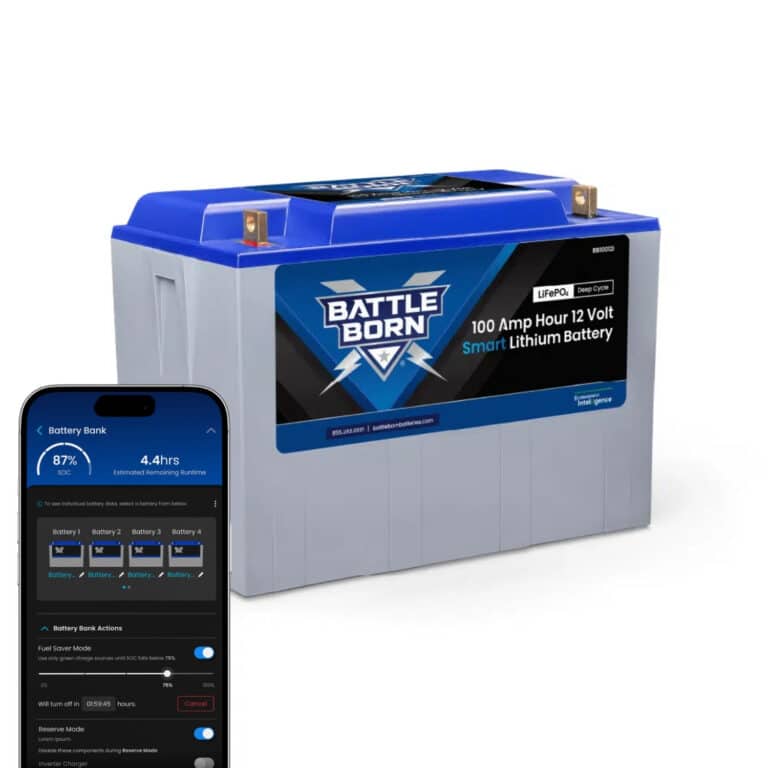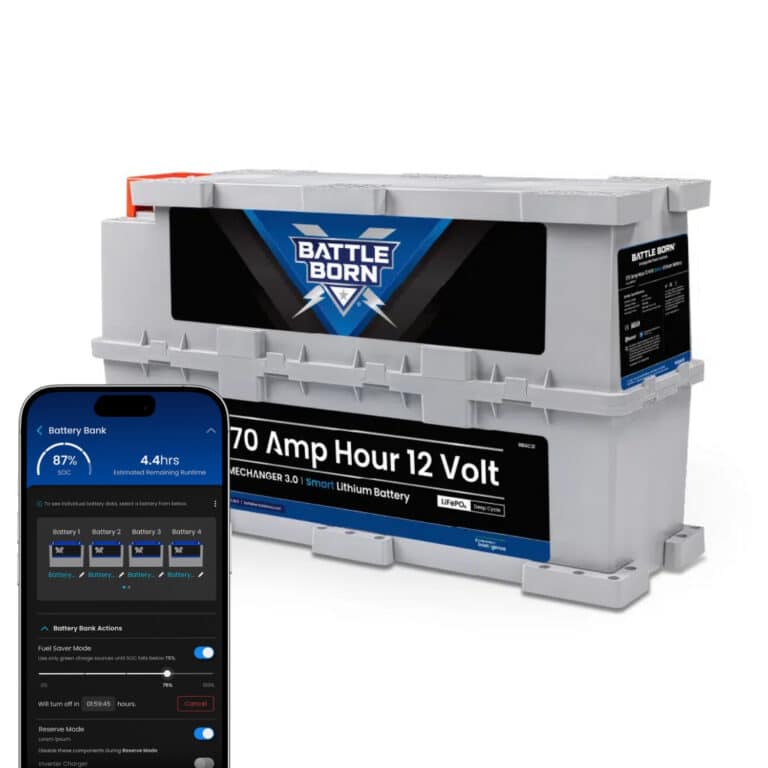
MENUMENU
TALK TO AN EXPERT
Special Hours: 7AM – 6PM PST
TALK TO AN EXPERT
Special Hours: 7AM – 6PM PST
Here at Battle Born Batteries, we understand that the process of getting the basics down for our products can be a confusing one. In this blog, we’ll address a few topics about lithium-ion batteries like charging, installation, and balancing.
To begin, there are lots of different ways to charge a battery. We have several brands that we recommend and are known to be compatible with our products, such as Victron or Progressive Dynamics.
Our team gets this question daily, and we have a blog post that helps address that topic. There are three main ways to charge a system: solar, alternator, and shore.
One component we often recommend is the Victron Energy SmartSolar MPPT charge controllers for systems equipped with solar. With Solar Charge Controllers we recommend the following settings:
We also frequently suggest Victron’s IP-65 Blue Smart Charger because it’s water-resistant, Bluetooth compatible and has a charging profile for lithium batteries and other battery chemistries. The IP-67 is waterproof as well, and a great choice for your system. This device connects directly to the battery and is meant for single-battery charging. It’s great for those with trolling motor applications or those with battery systems connected in series.
For alternator charging, we often recommend using a DC-to-DC charger or battery-to-battery charger. The Victron Orion-TR Smart DC-DC isolated charger is an adaptive, three-stage charger with algorithms for bulk, absorption, and float options. You also can mix battery chemistries safely with this device, such as your AGM starting battery to your lithium house bank. Aim for a range between 14.2V and 14.6V with bulk and absorption stages and for the float stage, 13.6V is best. While lithium technically doesn’t need to be floated, a good majority of the devices out there still have a float charge mode. The batteries naturally float at 13.6V but reaching 14.6V is ideal and needs to happen in order to engage its balancing mechanisms. For more additional resources, check out our blogs on charging LiFePO4 batteries and the basics of charging.
When we ship our batteries through ground transport, they are typically close to fully charged. We use a bit of the battery’s energy to test its safety functions such as the temperature and voltage current cutoffs.
If we ship a battery for sea or air shipment, we are required to discharge the battery to a 20 percent state of charge. So if you receive an express delivery or live overseas, you will need to charge it up when you get it.
We rely on our partners at Victron as they offer three types of BMV models for systems. The BMV 700, 702, and 712. The differences between them are fairly simple: the BMV 700 only monitors your house bank and does not have Bluetooth built in. The BMV 702 monitors the house and starter banks, and gives the voltage on the starting battery. It also can accommodate a Bluetooth dongle to connect with the Victron app on your phone for monitoring.
As for the most popular unit that we sell, the BMV 712, is exactly like the 702 as it monitors the house and starting bank but has Bluetooth built in.
For more information about the BMVs and their ins and outs, check out our previous FAQ blog entry on the topic!
As for needing a shutoff switch for your battery, it’s great for maintenance and helps with the winterization process. The batteries will keep a lot of power in storage as our batteries have a low rate of natural discharge, and the disconnect switch is key to make sure that you don’t run down your batteries.
Inverters need to be ventilated. Please note that our team recommends keeping these heavy heat producers in an area where they can keep cool. These devices are prone to overheating, which can shorten their capabilities and lifespan overall.
You don’t need to your Battle Born Batteries to absorb while charging, but you do want to have them stay in the absorption stage for the battery cells to balance. Typically, we recommend 20 to 30 minutes per battery string in parallel.
What happens if you’ve got multiple batteries in series? In terms of balancing, they will need to connect from the positive to negative ends for a 48V system. Each of the batteries contain four cells in series internally, and each one has a battery management system to make sure it remains in balance. The charge cycle makes sure the cells are balanced. When in series, it’s a little more challenging to ensure that the cell packs are balanced properly due to a lack of bleed resistors (devices connected in parallel with an output of a high voltage power supply circuit for the purpose of discharging). The system also allows the higher charged packs to bleed down to meet the lower charged packs. It’s acceptable because there’s no external balancing and the internal balancing will create external balancing.
For example, if a battery is at a higher charge, when you get to the top of the charge cycle, around 57V or so, this battery could exceed its 14.4V limit and get closer to 15V. In that case, you could have all the cells above the prescribed threshold internally and they would all start to bleed so this battery is discharging down to meet the other ones and that tends to keep this bank in balance.
There are ways to accelerate that process. For example, a multibank charger makes sure every charge cycle keeps each battery in the same state of charge. Generally, if you’ve got a 48V bank and you are keeping them regularly at 57V on each charge cycle, then they’ll remain balanced. It’s possible to reach the high voltage limit on one of the batteries if one cell exceeds that threshold, the limit will cut off the charging current to all the additional batteries. Since you could have a smaller imbalance for many reasons, like temperature extremes or high loads, it then would be possible for the cutoff to happen lower than 57.6V, even at 57.2V or lower. In that case, there’s nothing wrong with lowering that bulk absorption down to 57V or even lower until that cutoff stops happening. Then over time raising it up because the batteries will be more and more imbalanced.
In short, even though there is no external balancing, the internal balancing will provide some external balancing, keeping the packs in balance with each other in a series system operating at 24V, 36V, or 48V.
As for balancing the lithium-ion batteries, we typically expect them to be charged up to 14.4V as that’s when the passive balancing mechanism kicks in. If you’re floating at 13.6V, there’s no balancing happening and you’re not going to balance the cells until you charge it up to around 14.4V, or at least 14.2V. This won’t be required if you’ve got a solar charge controller or if you have a battery-to-battery charger for alternator charging. These devices can accommodate 14.4V on every charge, so you don’t need to worry about it.
If you don’t typically charge at up to 14.4V your cells may get a bit out of balance because of temperature extremes or larger loads. To rebalance your system, we recommend being able to charge it up to 14.4V once a month or even once a week. Please note that it depends on your system usage. You may not notice anything, but if the batteries are hitting high voltage disconnect sooner than you’d expect, for example at 14V, or if they’re hitting low voltage disconnect sooner than you’d expect, such as at 11.5V , then you may want to think about rebalancing the battery cells internally and all you must do is charge it up to 14.4V in order to rebalance the cells.
What is high voltage disconnect? When one of the cells exceeds a certain prescribed voltage, the lithium-ion battery will prevent a charging current from entering. That means the cells can no longer receive a charge to exceed voltage that puts them out of operational specs. In high voltage disconnect, it isn’t disconnected from your system. Even though the battery won’t take a charge current, it will always allow a discharge current. As soon as you start trying to draw current from the battery while it’s in high voltage disconnect, it can still power your system with that current.
If you have any additional questions or concerns about your lithium-ion battery bank, check out the other blog entries from this series. Our YouTube channel also addresses plenty of topics. Lastly, if you need additional assistance, please contact our sales and tech team at 855-292-2831 or send an email to [email protected].
Shop Best Sellers








Ask a technical specialist now at 855.292.2831
Stay in the Know